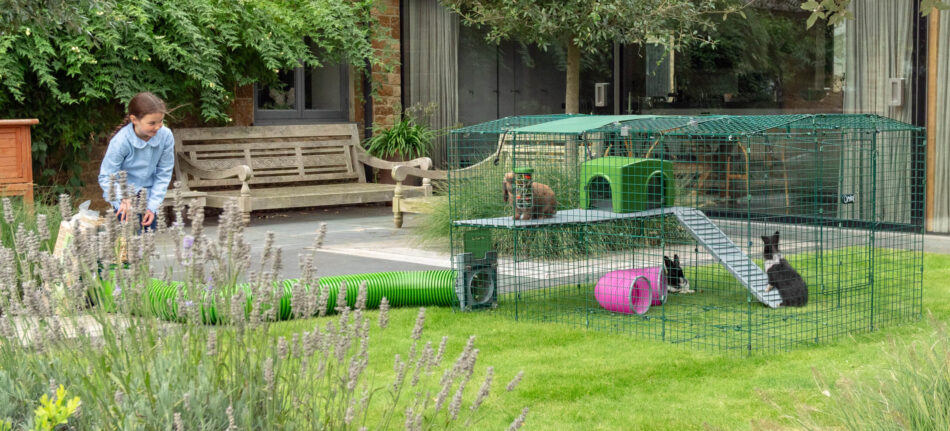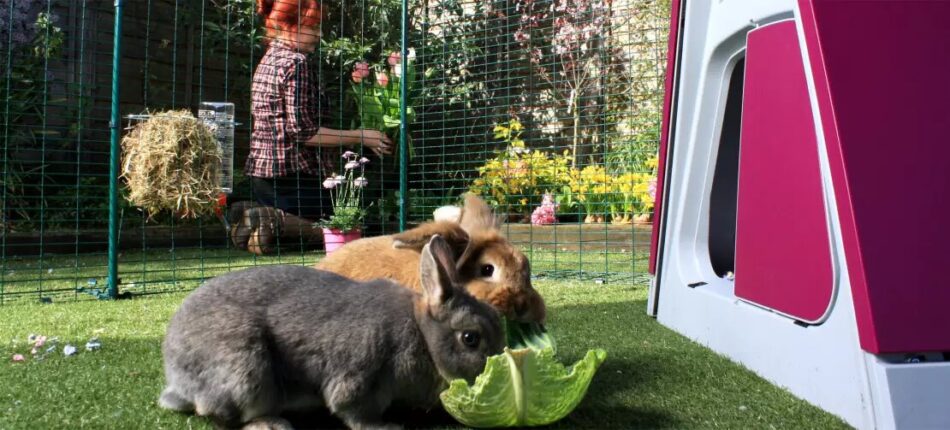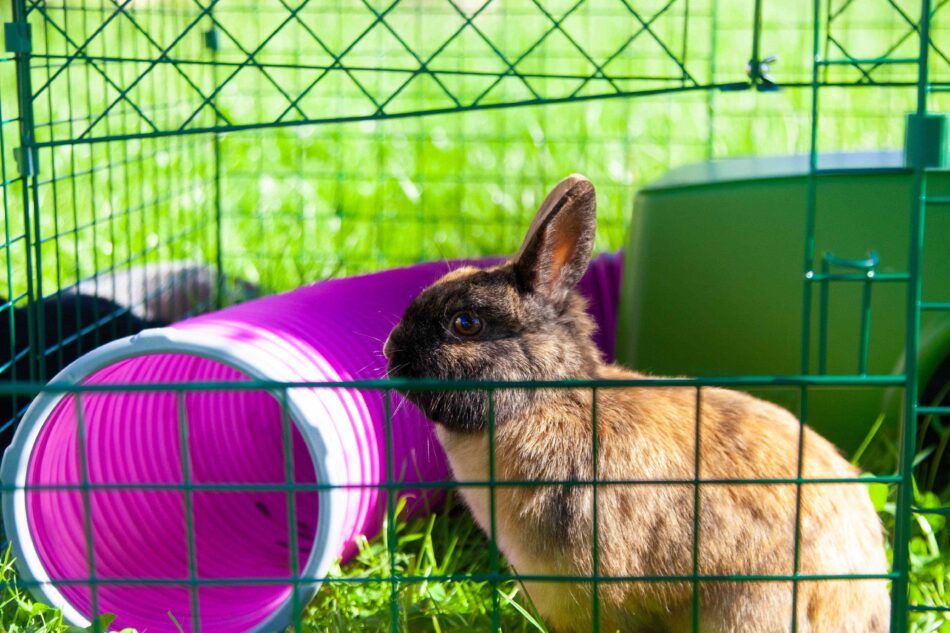Plant a Garden, Feed a Rabbit
The story of Peter Rabbit by Beatrix Potter paints a fairly bleak picture of a rabbit’s life in a garden. In fact, rabbits earn a bad reputation around the world as garden menaces. Their fast metabolism and curious natures drive rabbits to seek the tastiest and most nutritious vegetation, which inevitably lands them in a predicament much like Peter found himself in! But with a little planning and mindful designing, your garden can be free of the strife that Mr. McGregor experienced!
Our domesticated rabbits have the same instincts as their wild counterparts. In the wild, rabbits live in almost every climate imaginable, and can be found on every continent except Antarctica! This means they have to be able to eat a wide variety of plants to sustain themselves. Wild rabbits are also expert excavators, capable of digging extensive networks of tunnels and burrows. Unfortunately, both of these behaviors can spell bad news for a backyard gardener.
But what if our pet rabbits could live in harmony with our backyard plants, just as wild rabbits cohabitate with their native vegetation? What if digging and burrowing could work to the gardener’s advantage while encouraging our pet bunnies to foster their natural instincts?
A rabbit-ready garden
Rabbits are seriously misunderstood as gardening-assistants! If the proper care is taken when designing a backyard garden, pet rabbits can actually be very helpful when tending plants. They’ll trim the ends and edges of plants they are allowed access to, turn the soil through digging and burrowing, and mow stray patches of grass and invasive weeds. As an added bonus, those round bunny poops are actually little nuggets of garden gold! Rabbit manure is one of the best fertilizers for gardens, with many rabbit-keepers saving a stash to add to their compost and natural fertilizers.
But what plants are rabbit-safe? And how much is too much?
Here is a list (which is by no means exhaustive!) of gardening favorites that are both delicious and nutritious for your backyard bunny:
Garden “Staples”:
- Arugula
- Bell Pepper
- Broccoli (leaves and stems are best)
- Brussel Sprouts
- Carrots and Carrot Tops
- Celery
- Fresh Grass (not clippings!)
- Greens (mustard, turnip, etc.)
- Herbs (basil, cilantro, dill, mint, parsley, rosemary, etc.)
- Lettuce (the darker the variety, the more nutritious!)
- Okra
- Radishes and their leaves
- Squash (summer, zucchini, etc.)
Flowers:
- Asters
- Carnations
- Geraniums
- Hibiscus
- Marigolds
- Nasturtium
- Pansies
- Roses
- Sunflowers
Fruits:
- Apples*
- Apricots*
- Bananas (peel removed)
- Cherries*
- Kiwi
- Mangoes*
- Melons
- Nectarines*
- Papaya
- Peaches*
- Pineapple
- Plums*
- Star Fruit
- Strawberries
* Safe when stems and seeds are removed, as high amounts can be toxic!
Additional ideas for naturally-found rabbit treats can be found here: Forage Treats For Your Rabbit.
As with most tasty things, too much of a good thing can be, well, too much! In order to keep your bunny from overeating (both for their sake and that of the plant!), you’ll need to wrap or surround your plants and shrubs in rabbit-proof mesh to restrict nibbling, or elevate your plants by using planters, plant stands, or raised flower beds. Multi-level gardening can be visually stunning, and your back will thank you when tending to vegetation in raised plant beds!
It’s important to remember that hay (such as timothy or orchard grass) should make up the majority of your pet rabbit’s diet – 75% to be exact! The other 25% of foods offered should be allocated for veggies, pellets, and small amounts of fruit.
Rabbit red-flags: plants to avoid
Not everything that grows in a garden is safe for your rabbit to consume, and they won’t know the difference between friend and foe when it comes to snacks. Anything plant-like looks appetizing to a rabbit! Take extra care not to plant any of the following where your bunny can accidentally sneak a nibble:
- Azalea
- Blue Bell
- Brugmansia (Angel Trumpet)
- Buttercup
- Christmas Rose
- Columbine
- Daffodil
- Dahlia
- Foxglove
- Hemlock
- Hyacinth
- Iris
- Ivy
- Lupine
- Lily of the Valley
- Milkweed
- Mistletoe
- Narcissus
- Nightshade
- Periwinkle
- Poppy
- Primrose
- Rhododendron
- Tulip
- Wisteria
- Yew
If you are concerned that your rabbit may have gotten a taste of a toxic plant, or is acting ill after consuming any vegetation, be sure to contact your veterinarian right away. It is also helpful to bring a sample of the plant that was ingested, or a picture of the plant in question for your veterinarian to identify.
Rabbit-friendly fertilizers and weed killer
Since rabbits like to dig and burrow in the ground, caution needs to be taken when conditioning your garden’s soil. Commercially bought fertilizers and weed killers contain many substances that are harmful to bunnies, and should be avoided.
Thankfully there are many alternatives to name-brand garden products – and you probably already have the ingredients in your pantry to make them yourself!
The best fertilizer for your garden is made through composting. Compost is super-food for plants, with the added bonus of being super-easy to start and maintain. Made from organic waste such as: food scraps, coffee grounds, dead leaves, grass clippings, weeds, etc., you can start composting as soon as your next meal! Compost piles can be made in a secluded part of your backyard or garden, or you can invest in a composting bin. No matter which method you choose, after a small amount of effort you’ll have an easy and nutritious boost for your plants that won’t harm your rabbits!
You can also add individual composting ingredients directly to the soil without waiting for them to break down. Some of the most common soil additives include coffee grounds, egg shells, banana peels, and manure (like what your bunny leaves for you!).
Be sure to exercise caution when adding things like coffee grounds or grass clippings to soil within your bunny’s reach, as ingestion could create digestive upset. It’s best to add actual compost at ground level, and individual ingredients to plants out of your rabbit’s reach.
While rabbits are excellent in helping to clear weeds, some stubborn varieties need a helping hand. This list of DIY weed killers offers rabbit-safe options:
- Vinegar and dish soap
- Rubbing alcohol and water
- Boiling water
Any of these solutions should be applied while your bunny is safely in their hutch to avoid any direct contact. Once the solutions have dried, it will be safe for your rabbit to resume outdoor activities!
Bunny boundaries
No matter how much space you allow your bunny to roam, you’ll need to make sure it’s both escape-proof and predator-resistant.
The Eglu Go Rabbit Hutch is an excellent option for the free-roaming rabbit. It’s compact enough to not take up too much real estate in your backyard, and sturdy enough to keep even the most persistent of predators out. Plus, the added run with an integrated no-dig wire floor is an instant outdoor housing solution for your bunny! Incorporate the wire run into your gardening aesthetic by planting rabbit-safe trailing vines, or by placing potted plants alongside the run for easy-access bunny snacks.
If your rabbit roams in a larger space, be sure to have their area covered with wire, or provide lots of plants that offer shade and foliage to hide from flying predators such as hawks and owls. Even if your rabbit is too large to be swept away by a bird of prey, these flying hunters can inflict injury on your bunny by attempting to pick them up. You can also provide escapes with the Zippi Rabbit Tunnel System of your own design, or functional garden decor for safe rabbit-retreats.
To dig or not to dig
Rabbits are diggers by nature. They create tunnels, burrows, or simply move dirt to create a soft and cool spot to settle into on a warm day. When allowed to dig in appropriate places, rabbits fulfill their innate desires and upkeep their physical health – which means happier bunnies and shorter toenails!
It’s important that any rabbit enclosure nestled on the ground have a dig-resistant liner all along the bottom. Even if you forgo having a designated run for your rabbit in favor of free-rein of the garden, all fences should be at least 3 feet tall, with wire-mesh buried at least 6 inches down to prevent escapes. As an added layer of protection, wire-mesh can be fixed to the bottom 6-8 inches of the fence, forming a 90 degree angle with another 6-12 inches tacked into the ground using landscape staples.
Be sure to check your boundary lines daily for any new tunnels that may present a problem. Rabbits are quite proud of their handiwork, and will often spend time in their new constructions, so watch for extending tunnels and burrows. It’s a good idea to mark tunnels to note their progress and to avoid stepping on the hollowed-out ground between an entrance and exit. Plant marking signs make adorable additions to your garden, and can be useful when marking rabbit construction zones!
Any tunnels that aren’t headed in a safe direction should be filled with dirt or gravel to prevent escape. And be sure to watch your step – rabbit tunnel entrances and exits are just the right size to swallow a shoe and turn an ankle! For more ideas on housing your bunny outside, check out: Rabbit-Proofing the Garden.
If allowing your rabbit to tunnel is not a safe or desirable activity for them, creating a network of Zippi Rabbit Tunnel System components is a fun and safe way to curb their tunneling cravings! By connecting Zippi Rabbit Runs and Playpens together, and adding physically and mentally challenging components such as Zippi Lookout Towers or Zippi Rabbit Run Platforms, your rabbit will be able to fulfill its frolicking needs!
Weather considerations
Rabbits are naturally equipped to handle a wide variety of weather conditions, but a little help from their humans goes a long way! If you are transitioning an indoor rabbit to staying outdoors, be sure to take temperature into consideration and avoid excessively warm or cool days at first. The ideal temperature for a rabbit is between 55℉ and 70℉, so aiming for days with mild temperatures will give your rabbit the smoothest transition possible.
Of course not every day will have ideal temperatures, but after getting acclimated to life outside, your rabbit’s coat and instincts will adapt to the weather. But to give them an advantage, rabbit weather protection and rabbit rabbit run covers can bolster your bunny’s natural defenses against the elements. Rabbits have a dense coat that will insulate them once they are accustomed to being outdoors in winter months, but an insulated hutch is a particularly good idea if you live in an area that experiences sub-freezing temperatures.
Rabbits fare better in cold temperatures than hot, so if you live in an area with excessive summer temperatures, be sure to keep a close eye on the thermometer as well as your bunny. Signs of rabbit heat stroke include:
- Rapid breathing or panting
- Drooling
- Lethargy
Bring your rabbit inside and contact your veterinarian right away if you suspect heat-related illness. Frozen water bottles or ice packs placed near your bunny’s favorite resting spot is one of the best ways to stave off overheating. Your bunny will appreciate having something cool to snuggle up to!
Omlet for the outdoors
At Omlet, we want your pets to live their most natural lives in the safest way possible. Our line of rabbit products are designed to allow your bunny to enjoy the great outdoors without compromising their security. Whether you have a background garden for your rabbit to prune, or keep them housed in a hutch/run combo with strategically placed herbs and edible plants to nibble on through the wire, we have the products to create the ultimate outdoor play space! Easy to set up, clean, and maintain, you’ll love your rabbit’s new setup almost as much as they will!
This entry was posted in Rabbits



2 replies on “Plant a Garden, Feed a Rabbit”
There are quite a few who don’t understand to make careful planning and design, a garden for rabbits, with your article it is very helpful to provide the right information
Bunnies visit my yard and eat the fallen birdseed (I think that’s what they’re eating 😬. I had the thought of a bunny garden! I have never had a garden but I think it would be fun to grow a small snack bar for them to enjoy 😊 Thanks for your useful tips and suggestions!